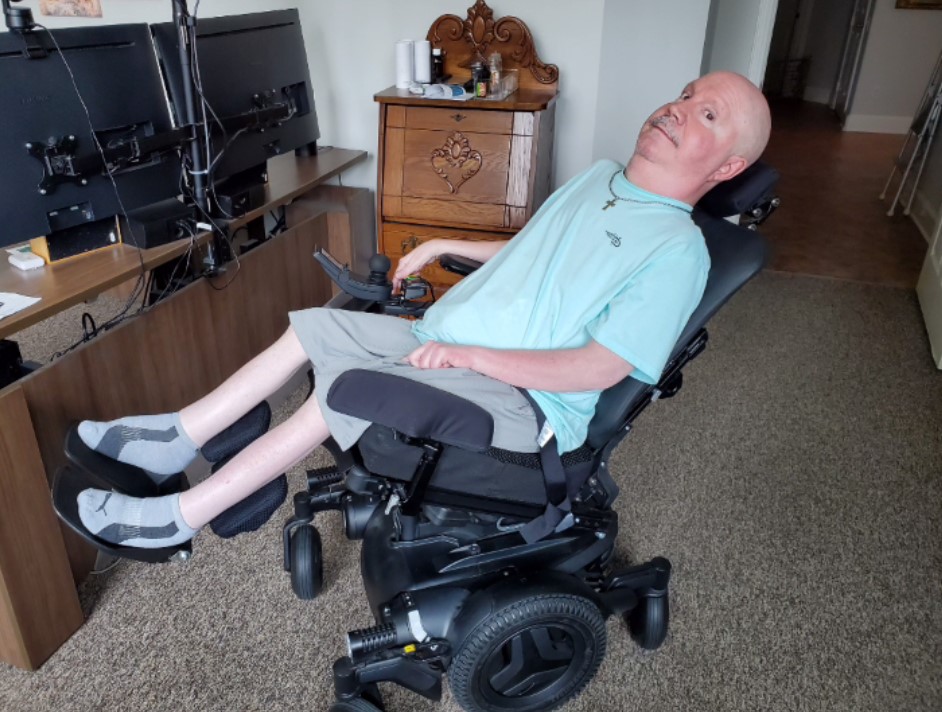Adjustments add up to more comfort in new wheelchair
Adapting requires patience, persistence, and knowledgeable team

Michael uses the reclining function on his new wheelchair to reduce the discomfort to his back and hips. (Photo courtesy of Michael Morale)
Michael, my patient who has spinal muscular atrophy (SMA), has recently transferred into a new wheelchair and was experiencing significant discomfort in his right hip while seated. We performed several different modalities and activities on Michael’s tailbone to increase his comfort. A combination of these adjustments was successful at reducing his pain and improving his comfort while sitting, as he does most of the day. As his comfort increased, other adjustments were being made as well.
Like anything new, there was a need for Michael to break in his new cushion for increased comfort and individuality. Michael has scoliosis and has one hip that sits lower than the other. He had his old cushion for so long, it was formed to his hips and back. This felt better to Michael because it didn’t force his hips to sit evenly, so many changes needed to be made to ensure Michael remained comfortable.
During the first couple weeks, Michael’s hips hadn’t formed to the contours of the new cushion. After sitting on it, the cushion started taking the shape of his hips and felt better. Michael’s tailbone became more centralized and the cushion was more supportive and helped reduce the amount of displacement he was experiencing. This can be attributed to the adjustments and modalities as well as time itself: Michael’s body was given time to adjust in the chair and allow for the extra support so that it wouldn’t see it as pain.
In conjunction with his physical therapy, we quickly realized if we made a few other adjustments, this would help with Michael’s comfort level. Michael’s wheelchair is customizable and allows for much more independence and comfort, and over time, the little adjustments he began to make to his chair reduced his pain level.
One of these adjustments was to his footrests. We quickly realized his footrests were too low, which didn’t allow for proper support. Raising his footrests about an inch reduced the pressure on the back of his legs which helped significantly with pain in his feet and calves.
Another adjustment needed was to reposition the joystick controller. The controller was too far away from his hand, which forced him to reach out and made it difficult for him to turn left and right. When Michael’s hands get cold, he loses the ability to grip items. The wheelchair company was able to move the joystick controller closer to his hand, which gave him the ability to maneuver without straining.
The amount of time his wheelchair would remain on and active also had to be adjusted. When Michael received his wheelchair, the manufacturer had set the controls to automatically turn off after 30 minutes of inactivity. When Michael was sitting at his desk, he was unable to turn the chair back on because the joystick controller was under the desk. The wheelchair company came out and turned off the automatic 30-minute timeout setting, so now his wheelchair remains on until he or one of his caregivers turns it off.
As time goes on there will be more adjustments needed, and we will continue to address these as they arise and change our treatment plan as needed.
Patient perspective
I knew there would be adjustments needed for my new wheelchair, but I never realized how difficult this process would be.
Patients who sit in wheelchairs have difficulty transferring comfortably from one wheelchair to the other, because our bodies are unable to adjust quickly to changes, especially when it comes to sitting in something that we are not familiar with. We can’t just go from one sitting position to another, because over time our bodies cannot make these rapid changes. Learning this was a difficult and painful reminder as to the amount of damage we’ve done to our bodies over the years.
When I was a child, maneuvering from one sitting position to another was easy, because my body hadn’t gone through the amount of atrophy and damage that I now experience as an adult. Reality can be a cruel teacher, but with the proper help, adjustments can be made. My physical therapist, Emily, has been working with me to make these adjustments, and without her, I’m not sure I would’ve been able to do this on my own.
I’m one of the biggest advocates for physical therapy, especially when it comes to patients with SMA. Emily has gone above and beyond the call of duty when it comes to caring for not only my physical health, but also my mental health.
Her ability to make these adjustments has been invaluable, and every SMA patient should have a physical therapist who cares as much for them as she does for me. I’m now sitting more comfortably in my wheelchair because of the changes mentioned above, and I know that when it is time to get a new wheelchair, I’ll be able to make these adjustments without these same difficulties.



